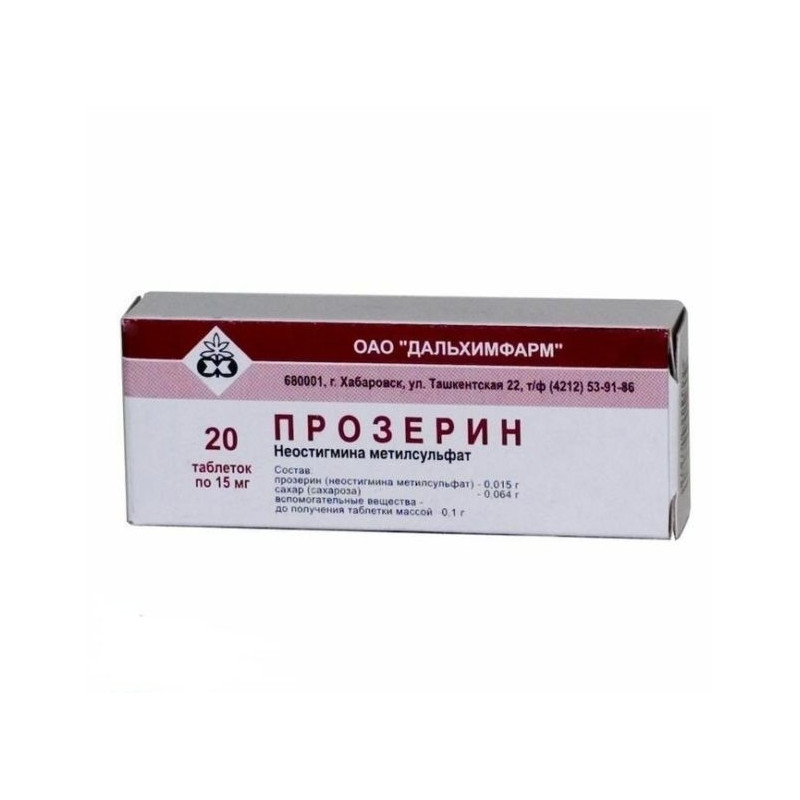



 All payments are encrypted via SSL
All payments are encrypted via SSL
 Full Refund if you haven't received your order
Full Refund if you haven't received your order
:
Acetylcholinesterase and pseudocholinesterase inhibitor.
It has an indirect cholinomimetic effect due to reversible inhibition of cholinesterase and potentiation of the action of endogenous acetylcholine.
It improves neuromuscular transmission, strengthens the motility of the gastrointestinal tract, increases the tone of the bladder, bronchi, secretion of exocrine glands.
Causes bradycardia, lowering blood pressure. Narrows the pupil, lowers intraocular pressure, causes a spasm of accommodation.
Pharmacokinetics:
After parenteral administration of neostigmine, methyl sulfate is hydrolyzed and also metabolized in the liver to form inactive metabolites.
Plasma protein binding is 15-25%.
Excreted in the urine (80% within 24 hours) as an unchanged substance (about 50%) and metabolites.
Bad penetrates through the BBB.
:
-Miastia and myasthenic syndrome, motor disorders after brain injury, paralysis, recovery period after meningitis, polio, encephalitis;
weakness of labor (rarely);
-atrophy of the optic nerve, neuritis;
-atonia of the stomach, intestines and bladder.
- Elimination of residual disorders of the neuromuscular transmission of non-depolarizing muscle relaxants.
-In ophthalmology: to constrict the pupil and lowering intraocular pressure in open-angle glaucoma.
Dosing regimen:
Inside adults - 10-15 mg 2-3; p / c - 1-2 mg 1-2
Inside to children till 10 years - on 1 mg / for 1 year of life; for children over 10 years old, the maximum dose is 10 mg. P / C dose is calculated at 50 mcg for 1 year of life, but not more than 375 mcg per injection.
In ophthalmology: injected into the conjunctival sac 1-4
Maximum doses: for adults with oral intake a single dose is 15 mg, daily - 50 mg; with s / c injection single dose - 2 mg daily - 6 mg.
:
- For the digestive system: nausea, vomiting, diarrhea, hypersalivation, flatulence, spastic contraction and increased motility.
- For the central nervous system and peripheral nervous system: headache, dizziness, weakness, loss of consciousness, drowsiness, miosis, visual disturbances, twitching of skeletal muscles (including muscles of the tongue), convulsions, dysarthria.
- From the side of the cardiovascular system: arrhythmias, brady- or tachycardia, AV-blockade, nodal rhythm, non-specific ECG changes, decrease in blood pressure.
- On the part of the respiratory system: shortness of breath, respiratory depression, increased secretion of bronchial glands, increased bronchial tone.
- Allergic reactions: skin rash, itching, facial flushing, Anaphylactic reactions are possible.
- Other: arthralgia, increased urination, increased sweating.
:
-Epilepsy,
Hyperkinesis
-vagotomy,
-bronchial asthma,
- IBS (including stenocardia),
arrhythmias, bradycardia,
- pronounced atherosclerosis,
-thyrotoxicosis,
- ulcer disease of the stomach and duodenum,
-peritonitis,
- mechanical obstruction of the gastrointestinal tract or urinary tract,
- hyperplasia of the prostate gland,
acute infectious diseases
- intoxication in weak children,
- increased sensitivity to neostigmine methyl sulfate.
Use during pregnancy and lactation:
Neostigmine methyl sulfate penetrates the placental barrier, in very small quantities excreted in breast milk.
During pregnancy and lactation, apply only under strict indications.
Special instructions:
Be wary when using Addison's disease.
For parenteral administration in high doses, prior or simultaneous administration of atropine is necessary.
When a myasthenic (due to insufficient therapeutic dose) or cholinergic (due to overdose) crisis occurs during therapy, a thorough differential diagnosis is required due to the similarity of symptoms.
Influence on ability to drive motor transport and control mechanisms
During the period of treatment, one should refrain from driving transport and other potentially hazardous activities that require concentration of attention and high speed of psychomotor reactions.
Drug Interactions:
Neostigmine Methylsulfate is an antagonist of non-depolarizing muscle relaxants and, when applied simultaneously, enhances the action of depolarizing muscle relaxants.
With simultaneous use of m-anticholinergics, ganglioblockers, quinidine, procainamide, local anesthetics, tricyclic antidepressants, antiepileptic and antiparkinsonic drugs reduce the effect of neostigmine methyl sulfate.
Ephedrine potentiates the action of neostigmine methyl sulfate.
With the simultaneous use of neostigmine methyl sulfate with beta-blockers may increase bradycardia.
Storage conditions:
List A.: In a dry, the dark place at a temperature of no higher than 25 ° C.
